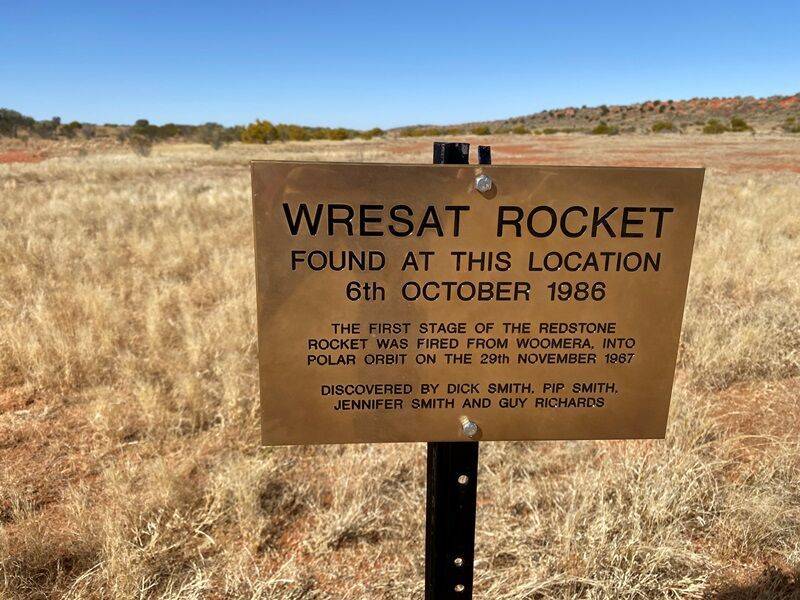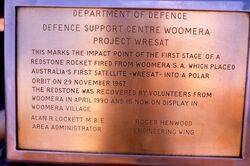
Home » Themes » Technology » Industry
WRESAT Redstone Rocket Print Page 
Two plaques mark the site where the first stage of the WRESAT Redstone Rocket landed in November 1967.
At 2.19 pm on 29 November 1967 , WRESAT, the first Australian satellite, was launched into orbit from Woomera in South Australia, making Australia only the third nation to design and launch a satellite from its own territory.
In 1966, Australia’s Weapons Research Establishment (WRE) was involved in the joint US-UK-Australia Special Anti-missile Research Tests (SPARTA) project to investigate the physics of missile warheads as they re-entered the Earth’s atmosphere. To launch dummy warheads for the tests, the United States shipped ten modified Redstone rockets to the Woomera test range.
The Redstones were converted ballistic missiles that had already been used to launch Explorer 1, America’s first satellite, in 1958, and Alan Shepard, America’s first astronaut, in 1961.
As the experiments progressed, the project team found that only nine of the ten rockets would be needed to complete the tests. WRE had to get official approval from the Australian Government, which had not previously shown any support for the idea of an Australian space program. Initially there was resistance, however when the US SPARTA team offered to prepare and launch the rocket, NASA offered to track the satellite for free, the University of Adelaide contributed part of the cost of the satellite, and many other costs of the project were absorbed within existing project budgets, the project was given the official go-ahead.
The satellite was named WRESAT, short for Weapons Research Establishment Satellite, but the United States offer had placed the project on a tight schedule. With the United States team returning home in 11 months, WRESAT would have to be designed, built, tested, and launched before they left.
The University of Adelaide team developed an instrument to measure the effect of solar radiation altering the temperature and composition of the upper atmosphere. Further instruments measured ultra-violet light and x-ray emissions from the Sun. A photocell fitted with a special filter was able to measure light at frequencies absorbed by ozone. As it orbited the Earth, WRESAT would see a sunrise and sunset every 90 minutes, so another detector was designed to determine the density of oxygen in the atmosphere by measuring the absorption of sunlight during sunrise and sunset. A magnetometer would monitor the satellite’s orientation with Earth’s magnetic field, and a small telescope was added to study the geocorona, the very outermost part of the atmosphere.
To save time and effort developing a new aerodynamic model, WRESAT and its equipment were built into an existing SPARTA rocket nosecone.
The planned launch day was Tuesday 28 November 1967. The rocket was ready, the satellite perched on top, and Woomera inundated by politicians, VIPs, and the media to observe the launch. Preparations proceeded smoothly, and the countdown started. Then, 30 seconds before the launch, a small heater-cooler unit drop tank attached to the side of the rocket failed to detach. The launch sequence was aborted and the flight rescheduled for the following day. On 29 November 1967 at 2.19 pm WRESAT lifted off on its way to orbit.
The modified Redstone was a three-stage rocket. Two minutes after launch, the first stage had exhausted its fuel, shutdown, and separated itself. The second stage continued onwards to carry WRESAT into space, with a third stage providing a final boost.
The launch of WRESAT made Australia only the third nation to build and launch a satellite from its own territory – the first two were space powerhouses the United States and the Soviet Union. It was a significant technological achievement and was an outstanding demonstration of Australian expertise and capabilities.
Location
| Address: | Approximately 356 kilometres south-east of Alice Springs, Simpson Desert |
|---|---|
| State: | NT |
| Area: | AUS |
| GPS Coordinates: | Lat: -25.483089 Long: 136.857522 Note: GPS Coordinates are approximate. |
Details
| Monument Type: | Plaque |
|---|---|
| Monument Theme: | Technology |
| Sub-Theme: | Industry |
| Actual Event Start Date: | 29-November-1967 |
| Actual Event End Date: | 29-November-1967 |
| Link: | https://australiascience.tv/wresat-… |
Dedication
| Actual Monument Dedication Date: | Friday 6th October, 1989 |
|---|
Plaque :
Department Of Defence
Defence Support Centre Woomera
Project WRESAT
This Marks The Impact Point Of The First Stage Of A Redstone Rocket Find From Woomera S. A Which Placed Australia`s First Satellite - WRESAT - Into Polar Orbit On 29 November 1967.
The Redstone Was Recovered By Volunteers From
Woomera In April 1990 And Is Now On Display In
Woomera Village.
Alan R. Lockett M. B. E. Roger Henwood
Area Administrator Engineering Wing
Plaque :
WRESAT ROCKET
Found At This Location
6th October 1986
The First Stage Of The Redstone
Rocket Was Fired From Woomera, Into
Polar Orbit On The 29th November 1967
Discovered By Dick Smith, Pip Smith,
Jennifer Smith and Guy Richards





 Australian Geographic article
Australian Geographic article
